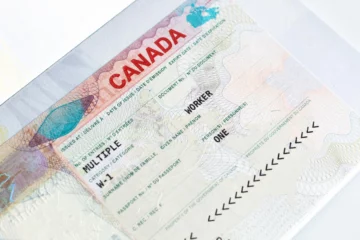Immigrating to Canada is a complex process, and one of the key steps for many newcomers is obtaining a work permit. In this article, we will explain the different types of Canadian work permits available for immigrants, including employer-specific work permits, open work permits, and spousal open work permits. We will also cover the Labour Market Impact Assessment (LMIA) process and the Temporary Foreign Worker Program (TFWP), which are critical for understanding the requirements and limitations of each type of permit.
Table of contents
Applying for a Work Permit in Canada
Most immigrants need a work permit to work in Canada. There are two types of permits for work. An employer-specific Canadian work permit and an Canadian open work permit.
What is an Employer-Specific Work Permit?
An employer-specific work permit outlines the specific name of the employer you are allowed to work for, the duration for which you can work, and the location of your job (if applicable).
For an employer-specific work permit application, your employer must provide you with:
- A copy of your employment contract
- Either a copy of a labour market impact assessment (LMIA) or an offer of employment number for LMIA-exempt workers (your employer can get this number from the Employer Portal)
Labour Market Impact Assessment (LMIA)
An LMIA is a document that employers in Canada may need to obtain before they hire an international worker. An LMIA will be granted by service Canada if there is a need for an international worker to fill the job in Canada. It will also demonstrate that no worker in Canada or permanent resident is available to perform the job. A positive LMIA is also called a confirmation letter. If an employer requires an LMIA, they have to apply for one.
Temporary Foreign Worker Program (TFWP)
The TFWP allows employers in Canada to hire foreign workers temporarily to fill jobs when Canadian workers are not available. Employers submit applications requesting permission to hire temporary foreign workers. These applications are assessed by Service Canada which also conducts an LMIA to evaluate the effects of these foreign workers on the Canadian labour market. Employers must comply with certain obligations in order to be allowed to continue to hire foreign workers. The TFWP is regulated through the Immigration and Refugee Protection Regulations and the Immigration and Refugee Protection Act.
What is an Open Work Permit?
An open work permit enables you to be hired by any employer in Canada unless the employer is listed as ineligible (https://www.canada.ca/en/immigration-refugees-citizenship/services/work-canada/employers-non-compliant.html) or regularly offers erotic dance, massages, or escort services. Open work permits are only given under specific situations. To see which work permit you are eligible you can answer the questions under “Find out what you need” link on the government of Canada immigration page (https://www.canada.ca/en/immigration-refugees-citizenship/services/work-canada/permit/temporary/need-permit.html).
An open work permit is not job-specific, therefore, you will not need Employment and Social Development Canada to provide an LMIA or show proof that your employer has given you an employment offer through the Employer Portal.
Spousal Open Work Permit
As of October 21, 2022, partners or spouses have to submit their permanent residence application online. They will then receive an acknowledgment of receipt (AoR) letter that confirms their application is being processed. Once they receive the AoR letter, they can apply for an open work permit online.
Other Types of Work Permits in Canada
Facilitated LMIA (Quebec)
Facilitated LMIA allows employers to apply for an LMIA without showing proof of recruitment efforts, making it easier for employers to hire foreign workers for select occupations. This only applies to employers in Quebec. This includes specialized occupations whose list is updated yearly. According to the facilitated process, the job offer wage will determine if the employer needs to apply for an LMIA under the Low-wage Positions stream or the High-wage Positions stream, each of which have their own requirements. If the employer is offering a temporary foreign worker a wage that is at or above the median hourly wage of the province or territory, they must apply for an LMIA under the high-wage position stream. If the wage is below the median hourly wage for the province or territory then the employer applies under the low-wage position stream.
The facilitated LMIA includes high demand occupations and industries experiencing labour shortages in Quebec. The list of occupations can be found, in French only, here (https://www.quebec.ca/emploi/embauche-et-gestion-de-personnel/recruter/embaucher-immigrant/embaucher-travailleur-etranger-temporaire). These include occupations classified under the National Occupational Classification (NOC) training, education, experience and responsibilities (TEER) 0-4.
Global Talent Stream
The global talent stream allows employers to hire in-demand workers or uniquely skilled talent in elect occupations to help their businesses grow. This program allows employers in Canada to use highly-skilled global talent to expand their workforce to meet client-specific needs and to be competitive on a worldly scale. It is part of the TFWP designed to allow employers to access unique talent to help their business grow. It is also intended to fill positions for in-demand highly-skilled positions as listed under the Global Talent Occupations List (https://www.canada.ca/en/employment-social-development/services/foreign-workers/global-talent/requirements.html#h20).
If hiring via this stream, the employer needs to develop a Labour Market Benefits Plan, which shows the employer’s dedication to activities that will positively impact the Canadian labour market. This plan would undergo yearly Progress Reviews to evaluate how well the establishment is adhering to their commitments. Note that Process Reviews are separate from compliance-related obligations under the TFWP.
Work Permit Extensions
Can you extend an open work permit?
If your work permit is near expiry, you must apply to extend it at least 30 days before expiry. You can apply online to extend a work permit. If you apply to extend your permit before it expires, you are allowed to stay in Canada while your application is processed. If you applied to extend your permit and it expires after your application is submitted, you are authorized to work without a permit until a decision is made on your application. You can continue to work under the same conditions as outlined in your work permit. Employer-specific work permit holders need to continue with the same employer, job and work location while open work permit holders can change jobs.
If you applied to extend your work permit online, you will receive a letter that you can use as proof that you can continue to work in Canada even if your permit expires while your application is being processed. Note that this letter expires 120 days from when you applied. If a decision is still not made by that expiry date, you can still continue to work until a decision is made.
The Difference Between a Work Permit and a Work Visa
A visa allows entry into the country. A work permit allows the foreign national to work in Canada.
How to Apply for Bridging Open Work Permits?
A bridging open work permit (BOWP) allows you to continue working in Canada while you wait for a decision to be made on your permanent residency application. One is eligible if they applied to one of the following permanent residence programs:
- Permanent residence via Express Entry
- Provincial Nominee Program (PNP)
- Quebec skilled workers
- Home Child-Care Provider Pilot or Home Support Worker Pilot
- Caring for children class or caring for people with high medical needs class
- Agri-Food Pilot
The eligibility criteria for BOWP depends on whether you live in Quebec or in other provinces or territories in Canada. If living in Quebec, you must apply as a Quebec skilled worker. To be eligible you must live in Canada and plan to stay in Quebec. You may leave Canada while your application is being processed. If your work permit expires and you leave Canada, you cannot work when you return until you receive approval for your new application. You must also hold a Certificat de sélection due Québec (CSQ) and be the principal applicant on your permanent residency application. You must also have either a current work permit, an expired permit but maintained your worker status, or be eligible to restore your worker status.
If applying via the PNP, to be eligible for a BOWP you must be living in Canada and plan to live outside of Quebec when you submit an application for your BOWP. You must be the principal applicant on your application for permanent residency. You must also have either a current work permit, an expired permit but maintained your worker status, or be eligible to restore your worker status. Notably, there must be no employment restrictions as per your PNP nomination.
You can apply online for a BOWP, or on paper if you are having problems applying online. There are other eligibility criteria for the remaining permanent residence programs and one of our immigration professionals can assist you in understanding the pathways throughout your application process.
Visitor Visa to Work Permit in Canada
Eligibility for the Temporary Visitor Visa to Work Visa Policy
Typically visitors cannot apply for work permits from within Canada. Until February 28, 2023, a temporary public policy has been issued that allows some temporary visitors in Canada to apply for a work permit from inside Canada. To be eligible, you must be in Canada at the time of application, and apply for an employer-specific work permit until February 28, 2023. Note that this policy does not apply to those who applied before August 24, 2020 or after February 28, 2023. You must also have a valid visitor status when you apply for the work permit. If your status as a visitor has expired, you must restore your visitor status prior to applying for a work permit. If it has been less than 90 days past your the expiration of your visitor status, you can apply online to restore it.
Can You Change a Student Visa to a Work Permit?
The Post-Graduation Work Permit (PGWP) Program
The PGWP program allows intentional students who have graduated from designated learning institutions (DLIs) in Canada to get an open work permit. Notably, work experience in TEER categories 0, 1, 2, or 3 gained through the PGWP program allows graduates to apply for permanent residency via the Canadian experience class within the Express Entry program. Students that have completed their study program can work as per Immigration and Refugee Protection Regulations (IRPR) section 186(w) while a decision is made on their PGWP application, if they meet all of the criteria below:
- Current or previous holders of a valid study permit when applying to the PGWP program
- Enrolled at a DLI as a full-time student in a vocational, professional training, or post-secondary academic program
- Had the authorization to work off Camus without a work permit
- Did not go over the maximum allowable work hours
Overall, obtaining a work permit in Canada is a multi-step process that requires careful consideration of your individual circumstances and qualifications. Whether you are applying for an employer-specific permit or an open permit, it is important to work closely with your employer and understand the requirements of the LMIA and TFWP. By familiarizing yourself with the different types of permits and the application process, you can increase your chances of success and take the first step towards a rewarding career in Canada.
This blog post is for informational purposes only. Please consult a professional for advice.
Sources
- https://www.canada.ca/en/immigration-refugees-citizenship/services/work-canada/permit/temporary/need-permit.html
- https://www.cic.gc.ca/english/helpcentre/answer.asp?qnum=1163&top=17
- https://www.cic.gc.ca/english/helpcentre/answer.asp?qnum=176&top=17
- https://ircc.canada.ca/english/helpcentre/answer.asp?qnum=163&top=17
- https://www.canada.ca/en/employmegnt-social-development/services/foreign-workers/quebec/simplified-process.html
- https://www.canada.ca/en/immigration-refugees-citizenship/services/work-canada/permit/temporary/extend.html
- https://www.canada.ca/en/immigration-refugees-citizenship/services/work-canada/permit/temporary/extend/expired-permit.html
- https://www.canada.ca/en/immigration-refugees-citizenship/services/work-canada/permit/temporary/extend/after-apply.html#online
- https://www.canada.ca/en/immigration-refugees-citizenship/services/work-canada/extend-permit/bridging-open-work-permit.html
- https://www.canada.ca/en/immigration-refugees-citizenship/services/work-canada/permit/temporary/apply.html


1 Comment
Esrael · 14/12/2024 at 2:48 pm
Work